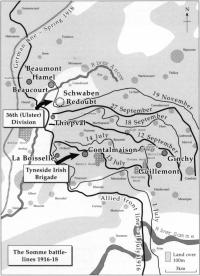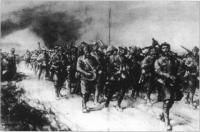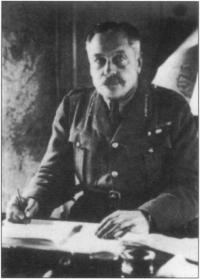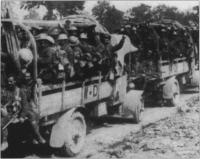The Irish at the Somme
Published in 20th-century / Contemporary History, Features, Issue 4 (Winter 1996), Volume 4, World War I![The Charge of the Ulster Division, Somme, 1st July, 1916[detail] by J. Prinsep Beadle. (Belfast City Council)](/wp-content/uploads/2013/02/87_small_1305292916.jpg)
The Charge of the Ulster Division, Somme, 1st July, 1916
[detail] by J. Prinsep Beadle. (Belfast City Council)
On 24 June 1916, 1,537 artillery pieces opened fire on German lines on a twenty-mile front. The bombardment continued until 7.30am on 1 July. This was the first time that such a large bombardment had been carried out and the British high command confidently expected that the German troops would be decimated, the few shell shocked survivors being only too eager to surrender.
On almost any other part of the German line these expectations might have been realised but the Somme sector, with its chalk sub-soil, had been put to good use by the Germans. A series of strong points, with bunkers up to forty feet (twelve metres) deep had been constructed to protect the six German divisions on the front. Critically of the 1,537 British artillery pieces, only 467 could be described as ‘heavy’ and of these only six fifteen-inch Howitzers could penetrate the deep bunkers. Therefore when the men of the sixteen British divisions (four regular, four territorial and eight Kitchener’s ‘new army’) went over the top on 1 July 1916, they were confronted, not by a handful of shell-shocked survivors, but by six well-prepared German divisions. What ensued was the biggest blood bath in the history of the British army.
Irish involvement
The prevailing impression that only Ulster Protestants took part in the long-awaited ‘big push’ on 1 July 1916 is called into question by the participation of other Irish infantry units. The 1,000-strong battalion (at full strength), subdivided into companies and platoons, was at this time the basic administrative unit of the British infantry. There were four battalions in a brigade and three brigades in a division. In addition to the twelve battalions of the 36th (Ulster) division, were four battalions of Tyneside Irish (the 103rd brigade of the 34th division)—all ‘new army’—and seven regular Irish battalions distributed in other divisions, a total of twenty-three Irish infantry battalions in all.
The objective of the 36th (Ulster) division was to dominate the area between Beaucourt to the north and Thiepval to the south, necessitating the capture of all German trench systems in front of them and particularly the strongly defended Schwaben Redoubt, nick-named ‘the Devil’s Dwelling Place’. In the weeks before the offensive the division had practised attacking dummy trenches. One veteran recalled that ‘you could have attacked those positions with your eyes shut, we had practised it so much’.
Meanwhile, officers of the 36th were convinced that the seven-day artillery bombardment would not only cut the six lines of barbed wire in front of them, but would also decimate the opposing Germans. One officer told his platoon, ‘Tomorrow you’ll just light your pipes and cigarettes, slope arms and walk across. It’ll be like a Sunday stroll. There’ll be no opposition’.
Two officers—Lieutenant Colonels Crozier (9th Royal Irish Rifles) and Bernard (10th Royal Irish Rifles)—took a much more pessimistic view. They both decided to disobey the divisional order instructing senior officers of the rank of lieutenant colonel and above not to take part in the assault. Crozier realised that if Thiepval village, which outflanked the 36th’s advance, held out then all the carefully laid plans would be rendered useless. He and Bernard concluded that if they did not lead the attack personally, none of the junior officers would have the nerve or experience to react to the situation and disobey orders if necessary.
The division was due to attack at 7.30am, four hours after dawn. Cyril Falls, a serving officer with the 36th, who later wrote its history, stresses that this was to allow the French artillery to carry out counter-battery fire. Falls believed that the British attack would have been more successful had it started at dawn. As it turned out the 36th suffered few casualties before the assault as they assembled under cover in Thiepval Wood, unlike other units, such as the Tyneside Irish.
 Timetabled bombardment
Timetabled bombardment
The artillery support for the 36th was firing to a rigid timetable: 7.20am, hurricane bombardment of the German front-line; 7.30am, as troops advanced, a barrage targeted on the second German line; 7.33am, a barrage targeted on the third line; 7.48am, a barrage targeted 400 yards behind the third line; 7.58am, a barrage targeted on the fourth line; 8.48am, a barrage targeted on the fifth line; 10.08am, a barrage targeted 300 yards beyond the fifth line. This system of artillery control was to have disastrous consequences but in the absence of reliable telephone or radio communication between the infantry and artillery it was the only option available.
At 7.10am, just before the bombardment reached its crescendo, the first wave of the 36th entered no-man’s land. Unlike other divisions which advanced in lines, the 36th sent its men forward in small groups to penetrate more effectively the breaks in the barbed wire caused by the shelling. No other British unit went over the top until the bombardment actually finished. These tactics, in conformity with contemporary French practice, gave the German defenders the minimum amount of time to respond and long lines of advancing men were not hindered by the lines of barbed wire.
The 108th and 109th brigades advanced first. These units were meant to capture the first four lines of German defences and the Schwaben Redoubt, then the 107th brigade would advance through them to capture the final German trench system. Initially the attack went well but then a number of factors combined to delay the advance.
As the attackers were sticking to the artillery’s rigid timetable many German dugouts were not cleared out effectively. The defences had survived the seven-day bombardment better than expected. German artillery quickly ranged in on the attackers . Leslie Bell recounts what happened to his unit:
We had no bother getting out of our trenches. You just had to walk out over the top of them. My platoon got thirty yards when a big shell exploded above us wiping out the whole lot. I was badly hit in the legs and was lying on the ground. Captain Robertson was running up with his platoon and as he ran past, give me a kick to see if I was still alive and could carry on. I was lying on my side and watched him and the others advance, until a shell burst above them and downed him and some of his men.

‘The return of the Dublins and Munsters from the victory of Ginchy.’ (Illustrated London News)
Orange handkerchief?
The 107th brigade coming up in support was badly shot up. Crozier recalls that German shells were falling on his unit at the rate of six per minute. The unexpected response shook the attackers morale. Bernard was killed leaving the 10th Royal Irish Rifles leaderless. Major George Gaffikin supposedly rallied them by holding up an orange handkerchief and roaring, ‘Come on boys, this is the 1st of July, no surrender!’. A single eye witness account of this incident was passed on to Michael MacDonagh who incorporated it into his 1918 The Irish on the Somme. Crozier, in The Men I Killed (1937) [possibly the most tasteless title in English publishing] relates, perhaps more plausibly, that he and some other officers had to threaten to shoot some men who were trying to retreat.
The Schwaben Redoubt held for two hours against all eight battalions of the first wave. The fighting was described by one soldier as ‘a Belfast riot on the top of Mount Vesuvius’. To make matters worse, Thiepval village successfully beat off the attack of the 32nd division and began to concentrate fire on the flank of the 36th..
‘The Tommies are here’
At this stage, many men of the 36th, were killed by ‘friendly fire’. Feldwebel Felix Kircher of the German 26th field artillery regiment recalled:
At 9 o’clock, I was down in my dug-out in the Staff Redoubt when someone shouted down to me in an amazed voice, ‘The Tommies are here!’ I rushed up and there, just outside the barbed wire, were ten or twenty soldiers with flat steel helmets. We had no rifle, no revolver, no grenades, no ammunition, nothing at all; we were purely artillery observers. We would have had to surrender but then the English artillery began to fire at our trench; but a great deal of shells were too short and hit the English infantrymen and they began to fall back. If the English could have got through they would have only met clerks, cooks, orderlies and such like. For a distance of several hundred metres to right and to left from us there were no German soldiers.
By 9am the 36th was thus holding the German front and Schwaben Redoubt. However if the advance was to continue fresh reinforcements were needed. As early as 8.30am this was clear to Major General Nugent, who asked corps headquarters if the 107th brigade should advance, as planned, without Thiepval having fallen to the 32nd division. At 9.15am he received instructions to halt the advance, but with telephone lines severed Nugent’s runner arrived too late to prevent the reserve troops from going over the top.
Communications farce
While fending off a German counter attack, Captain Norman Strong of the 10th Royal Inniskilling Fusiliers was made painfully aware that to some staff officers it was just another routine day:
In the middle of the battle, two runners were sent from brigade with a message; one was hit on the way and the other handed over the message to me. It read, ‘Please re-submit drawing of the foot of Private Warke, size of boot 13’. Private Warke, who had particularly big feet was in the middle of the Schwaben Redoubt at the time. I was furious that such a stupid message could be sent at such a time and stamped it into the mud.
The 36th held the German front-line and Schwaben Redoubt throughout 1 July, beating off three counter-attacks. By the evening nearly all the officers were casualties, ammunition was almost exhausted and no reinforcements had arrived. At this stage Lance Corporal J.A. Henderson and his men were ordered to retire: ‘As I was coming out I met the relieving troops moving up. I have never seen such a look of terror on the faces of human beings.’
‘The men cried and I cried’
The 2nd July found some units of the 36th still holding out. Corps HQ had been able to send only two battalions of West Riding Territorials as reinforcements. Later that day the shattered remains of the Ulster division withdrew as the 49th relieved them. The division had lost 5,500 officers and men killed, wounded and missing. At roll call on 3 July Captain Montgomery of the 9th battalion, Royal Irish Rifles recalled:
Not a few of the men cried and I cried. A hell of a hysterical exhibition it was. It is a very small company now. I took 115 other ranks and four officers (including myself) into action. I am the only officer and only thirty-four other ranks are with me now out of the 115.
The men of the 36th division behaved with the utmost bravery but ultimately their sacrifices were in vain. They were the only British division to reach the German second lines, but on 3 July they held little more ground than they had on the 1st. Some Unionist historians, for example Hugh Shearman in his Not An Inch: A Study of Northern Ireland and Lord Craigavon (1942), have blamed the poor support from the 29th and 32nd divisions, which operated on the flanks of the 36th, but this is grossly unfair. These divisions also lost heavily on the first day of the Somme and had tried their utmost to press home their attack. The experience of the 36th illustrates what happens to a successful unit if reinforcements are not immediately available to exploit its initial breakthrough.

Field-Marshall Haig – justified the losses.
The Tyneside Irish brigade
Other Irish units whose experience was very similar to the 36th division were the 24-27th battalions, Northumberland Fusiliers, better known as the Tyneside Irish brigade. This was one of the so-called ‘pals’ units which came into existence in September 1914 as a result of private initiative—in this case by the Newcastle Irish Club.
On the 1 July 1916 the objective of the Tyneside Irish brigade was the capture of the villages of La Boisselle and Contalmaison, once other units of the 34th division had secured the German front-line. The brigade had to cover over one mile of open ground even to reach the British front lines. However during this advance the brigade was subjected to heavy fire from their right, where the German front line outflanked the British. Sergeant T. Galloway described the advance:
I could see, away to my left and right, long lines of men. Then I heard the ‘patter, patter’ of machine guns in the distance. By the time I’d gone another ten yards there seemed to be only a few men left around me, by the time I had gone twenty yards, I seemed to be on my own. Then I was hit myself.
Thus the Tyneside Irish suffered heavy casualties before they even reached no-man’s land. Just one small group of around fifty men penetrated the German lines. Later it was reported that some of them had even reached Contalmaison. but none survived to tell of this struggle. The losses were horrific: in the 26th battalion, which suffered the fewest casualties, nineteen officers and 470 men were either killed or wounded.
Regulars
Regular battalions of Irish regiments were also heavily represented on the first day of the Somme. The 1st battalion, Royal Inniskilling Fusiliers, with the 29th division advanced across no-man’s land under heavy fire only to find the enemy’s barbed wire intact. They suffered 568 casualties in attempting to reach the German lines. The 2nd battalion, Royal Dublin Fusiliers, with the 4th division began to advance at 9am, immediately encountering heavy enfilade (or sideways) fire from Beaumont-Hamel. At 9.05am two runners arrived and informed Major Walsh, the commanding officer, that the attack was to be postponed. He managed to stop part of C and D companies advancing. However for the rest of the battalion, already in no-man’s land, the recall order came too late. At 12 noon, when the order was finally received from corps HQ to attack and consolidate the position, Walsh reported that this was impossible. Of the twenty-three officers and 480 men who had assembled that morning, fourteen officers and 311 men were now casualties. The order had to be amended and Major Walsh was now told to collect all available men to defend the British front-line.
Guillemont and Ginchy
This, then, was the contribution of the Irish to the ill-fated ‘big push’ of 1 July 1916. However, the Somme campaign was to stretch over a period of four months. A massive German offensive at the end of August was followed between 3 and 9 September by the battles for Guillemont and Ginchy in which the 47-49th brigades, 16th (Irish) division, were prominent. On 3 September the 47th brigade backing up the decimated 20th (Light) division made a significant advance but lost 1,147 out of the 2,400 attackers.
Between 4 and 8 September elements of the 16th division were used to reinforce the 5th and 20th divisions. Over this period of defensive trench warfare the 8th battalion, Royal Irish Fusiliers, alone had four officers killed and five wounded, thirty-six men killed, ninety-five wounded and forty missing. So far Ginchy had held against all attacks and on 9 September the 16th division was ordered to attack it. The bombardment started at 7am but the infantry were not detailed to attack until the late afternoon in the expectation that a German counter-attack would not be made until the following morning.

After the capture of Guillemont, 3 September 1916 –
men of the 16th(Irish) Division going back to rest.
Shelled by both sides
Yet again artillery support was far from ideal, as the 7th battalion, Royal Irish Rifles, war diary records. At 7.55am the commanding officer warned the 61st (Howitzer) brigade, Royal Field Artillery, that their shells were falling short in the British trenches. This message had to be repeated at 8.45am and again at 10.30am. At 11.08am the 8th battalion, Royal Inniskilling Fusiliers, also complained of shells falling short in their lines.
The 47th brigade was under strength even before going into action at Ginchy, on 7 September: there were 1,048 ‘effectives’, about one-quarter of the establishment of a brigade. At the last moment the attack was delayed for a further two minutes, to allow extra time for a final shelling of German trenches. However the 48th brigade did not receive this order and attacked at 4.45pm. The result was that the German counter-barrage fell on the tightly packed ranks of the 47th brigade, just as the men were preparing to go over the top. The brigade was then decimated by three hundred Germans with only five machine guns. Soon the assembly trenches were filled with dismembered bodies.
Against this stubborn resistance the 47th brigade failed to make any progress and lost 448 casualties on 9-10 September, about half of its remaining effectives. During this period, nevertheless, they successfully beat off several German counter-attacks. The brigade was relieved in the early hours of 10 September. Brigadier General Pereria reported:
The chief cause of the failure was that the enemy’s trenches were untouched by our artillery, their morale was unshaken and, when we attacked, we found them fully prepared.
Costly success
By contrast the 48th brigade achieved great success. It attacked in two waves, the 1st battalion, Royal Munster Fusiliers, and 7th battalion, Royal Irish Rifles, were to lead off, with the remaining two battalions following in support. Like the 47th, the 48th brigade was also severely under strength. Indeed, by 2pm, after enduring hours of shelling, much of it from British artillery, the 7th battalion, Royal Irish Rifles, had just 150 effectives; the 7th battalion, Royal Irish Fusiliers, the divisional reserve, was brought up to reinforce it and at 4.45pm both battalions attacked. Second Lieutenant Young of the 7th battalion, Royal Irish Fusiliers, remembered the scene:
The bombardment was now intense. Our shells bursting in the village of Ginchy made it belch forth smoke like a volcano… We couldn’t run. We advanced at a steady walking pace, stumbling here and there…(a shell) landed in the midst of a bunch of men about seventy yards away on my right. I have a most vivid recollection of seeing a tremendous burst of clay and earth go shooting up into the air—yes, and even parts of human bodies and that when the smoke cleared away there was nothing left. I shall never forget that horrifying spectacle as long as I live.
Nevertheless the brigade met ‘slight opposition’, and at 5.25pm Ginchy itself was captured. Unfortunately the 48th brigade paid a high price for this success; half the attacking force were casualties. The failure of the 47th brigade and the 55th division, on the 48th’s flanks meant that the unit became a focus for German counter-attacks, and it was shelled heavily during the night. Early on the next day the 16th Division, after its ordeal was relieved by the 3rd Guards brigade.
Haig’s spectacular failure
Thus ended Irish participation in the Somme campaign of 1916. It lasted from 1 July to 24 November, 147 days. The allies captured 120 square miles of land, and advanced six miles. They had suffered 419,654 casualties, forty men killed or wounded for every yard advanced (no reliable figures exist for German losses). Field-Marshal Douglas Haig justified the losses on two counts; firstly, the Somme offensive had relieved pressure from the hard pressed French forces at Verdun; and secondly, the British army in the Somme sector would have suffered very high casualties, up to 250,000 he reckoned, in the normal course of events, without staging an attack. However in making this statement Haig not only demonstrated his poor mathematical skills but neglected to mention that the Somme battles had tied up few German divisions and that the Russian offensive on the Eastern front had been primarily responsible for ending the German attacks on Verdun. It is difficult to see the Somme offensive as anything more than a spectacular failure, especially as during the spring offensive of 1918 German forces reoccupied every inch of ground in the Somme sector which the allies had captured in 1916.
Timothy Bowman is a postgraduate student in the Department of History, University of Luton.
Further reading:
T. Denman, Ireland’s Unknown Soldiers: the (Irish) Division in the Great War (Dublin 1992).
L. Macdonald, Somme (London 1987).
M. Middlebrook, The First Day on the Somme (London 1971).
P. Orr, The Road to the Somme. Men of the Ulster Division tell their story (Belfast 1987).
















